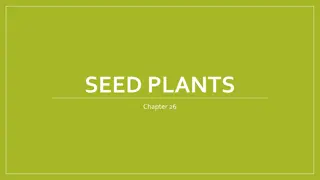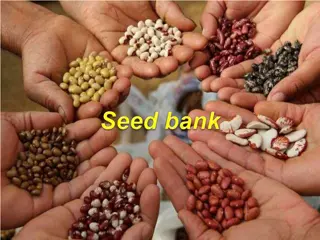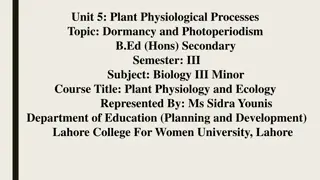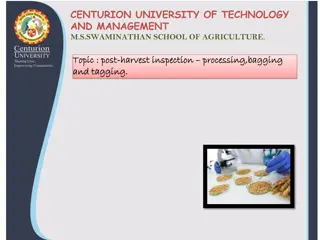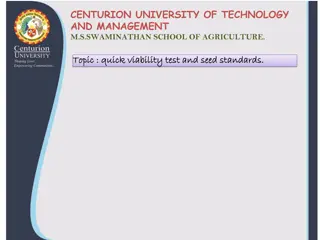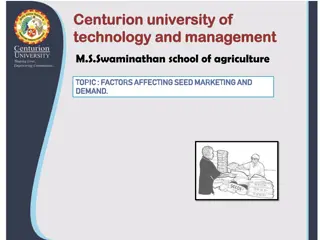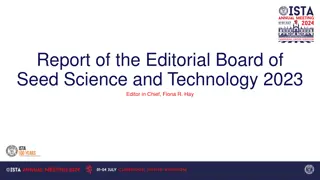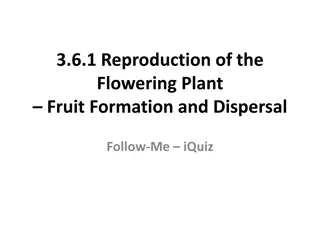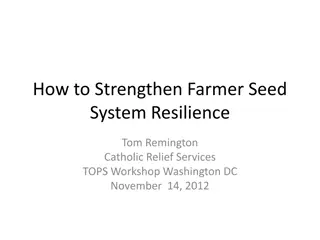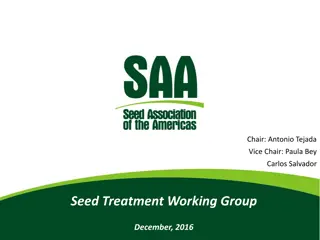
Seed Storage Principles and Purpose in Agriculture
Learn about the principles and purpose of seed storage in agriculture, emphasizing the importance of maintaining seed viability and vigour. Discover the stages of seed storage and why it is crucial for ensuring healthy plant growth and efficient production.
Download Presentation

Please find below an Image/Link to download the presentation.
The content on the website is provided AS IS for your information and personal use only. It may not be sold, licensed, or shared on other websites without obtaining consent from the author. If you encounter any issues during the download, it is possible that the publisher has removed the file from their server.
You are allowed to download the files provided on this website for personal or commercial use, subject to the condition that they are used lawfully. All files are the property of their respective owners.
The content on the website is provided AS IS for your information and personal use only. It may not be sold, licensed, or shared on other websites without obtaining consent from the author.
E N D
Presentation Transcript
Centurion university of technology Centurion university of technology and management and management M.S.Swaminathan school of Agriculture Topic Topic : seed storage : seed storage
TOPICSFDEYFHCDEHJYHVFBVJK CONTENTS CONTENTS Seed storage principles of seed storage principles of seed storage
Seed storage Principles of seed storage Maintenance of seed vigour and viability in terms of germination from harvest until planting is of the utmost importance in any seed production programme. Care should be taken at every stage of processing and distribution to maintain the viability and vigour. The harvested seeds of most of the orthodox crop seeds are usually dried and stored for atleast one season until the commencement of the next growing season, except those of the recalcitrant seeds which require high moisture content for safe storage (once dried the viability will be lost. E.g. Jack, Citrus, Coffee, Cocoa, Polyalthea, etc.,). In such recalcitrant seeds senescence starts in the mother plant itself. The dry weather alters moisture content of the seed, thereby reducing the viability. Some seeds require an after ripening process as in Pinus and Fraxinus.
Purpose of seed storage Seeds have to be stored, of course, because there is usually a period of time between harvest and planting. During this period, the seed have to be kept somewhere. While the time interval between harvest and planting is the basic reason for storing seed, there are other considerations, especially in the case of extended storage of seed. The purpose of seed storage is to maintain the seed in good physical and physiological condition from the time they are harvested until the time they are planted. It is important to get adequate plant stands in addition to healthy and vigorous plants. Seeds are also deliberately stored for extended periods so as to eliminate the need to produce the seed every season. Foundation seed units and others have found this to be an economical, efficient procedure for seeds of varieties for which there is limited demand. Some kinds of seeds are stored for extended periods to improve the percentage and rapidity of germination by providing enough time for a natural release from dormancy.
Regardless of the specific reasons for storage of seed, the purpose remains the same maintenance of a satisfactory capacity for germination and emergence. The facilities and procedures used in storage, therefore, have to be directed towards the accomplishment of this purpose
STAGES/SEGMENTS OF SEED STORAGE In the broadest sense the storage period for seed begins with attainment of physiological maturity and ends with resumption of active growth of the embryonic axis, i.e., germination. The entire storage periods can be divided into: 1 Post maturation /pre harvest segment Period from physiological maturity to harvest (seed in field) 2 Bulk seed segment Period from harvest to packaging (bulk seed in aeration drying bins,surgebins, etc.) 3 Packaged seed segment Period from packaging to distribution ( seed in packages in warehouse ). 4 Distribution/marketing segment Period during distributing and marketing (packaged seed in transit and retailers store house ). 5 On-farm segment Period from purchase to planting of seed (seed in on- farm storage ).
Seeds are considered to be physiologically and morphologically mature when they reach maximum dry weight. At this stage dry- down or dehydration of the seed is well underway. Dry-down continues after physiological maturity until moisture content of the seed and fruit decreases to a level which permits effective and efficient harvest and threshing. This stage can be termed as harvest maturity. There is usually an interval of time between physiological maturity and harvestable maturity, and this interval represents the first segment of the storage period. Any delay in harvesting the seed after they reach harvest maturity prolongs the first segment of the storage period often to the detriment of seed quality. The second segment of the storage period extends from harvest to the beginning of conditioning. Seed in the combine, grain wagon, and bulk storage or drying bins are in storage and their quality is affected by the same factors that affect the quality of seed during the packaged seed segment of the storage period. The third segment of the storage period begins with the onset of conditioning and ends with packaging. The fourth segment of the storage period is the packaged seed phase which has already been mentioned.
The packaged seed segment is followed by storage during distribution and marketing, and finally by storage on the farm before and during planting. The seed quality can be considerably be affected at any of the stages or segments mentioned above unless sound principles involved in seed storage are practiced and the seeds are properly handled. Types of storage The types of storage needed can be related to the time of storage expected. Broadly this can be classified into 4 types. 1. Storage of commercial truthfully labelled and certified seed. 2. Storage of carry over seeds. 3. Storage of foundation seed stocks and enforcement seed samples. 4. Storage of germplasm seeds. a) Storage of com m ercial seeds : This storage of commercial seed requires the largest storage need from harvest until planting. The storage period ranges from 8-9 months. Seed must be dried to 14 per cent moisture content for starchy seed and 11 percent for oilseeds. C arryover seeds : About 20-25 per cent of stored seed may have to be carried over through one season to the second planting time. The storage period may range 1-1 year. b)
Storage of seeds in metal bins with tight fitting lids or in a moisture proof bag will solve the problems of moisture penetration, provided the seeds are already dry enough for sealed storage. c) Foundation stock and enforcem ent seed sam ple : It is desirable to store foundation and enforcement seeds for several years since genetic drift are minimized by reproducing foundation or stock seeds. Since the quantity of seeds involved is not large, the storage room is only a small part of the total storage area and in fact, is often a small room within a large warehouse. Relative humidity and temperature combination has to be provided for maintaining the viability. A combination of 25 per cent RH at 30oC temperature or less or a RH of about 45 per cent at 20oC or less will be ideal. The required RH can be achieved by making the room moisture proof and by using a dehumidifier. d) G erm plasm seed storage : Germplasm seeds are required to be kept for many years, perhaps very long periods. Basic requirements for such long term storage are the coldest temperature economically possible and seed moisture is in equilibrium with 20-25 per cent RH. Germplasm storage built up so far have rooms which can be maintained at 5oC to 10oC and 30 per cent RH. In addition, the stored samples are dried to perfect moisture level.
PRINCIPLES OF STORAGE : 1. Seed storage conditions should be dry and cool 2. Effective storage pest control 3. Proper sanitation in seed stores 4. Before placing seeds into storage they should be dried to safe moisture limits. 5. Storing of high quality seed only i.e., well cleaned treated as well as high germination and vigour.

